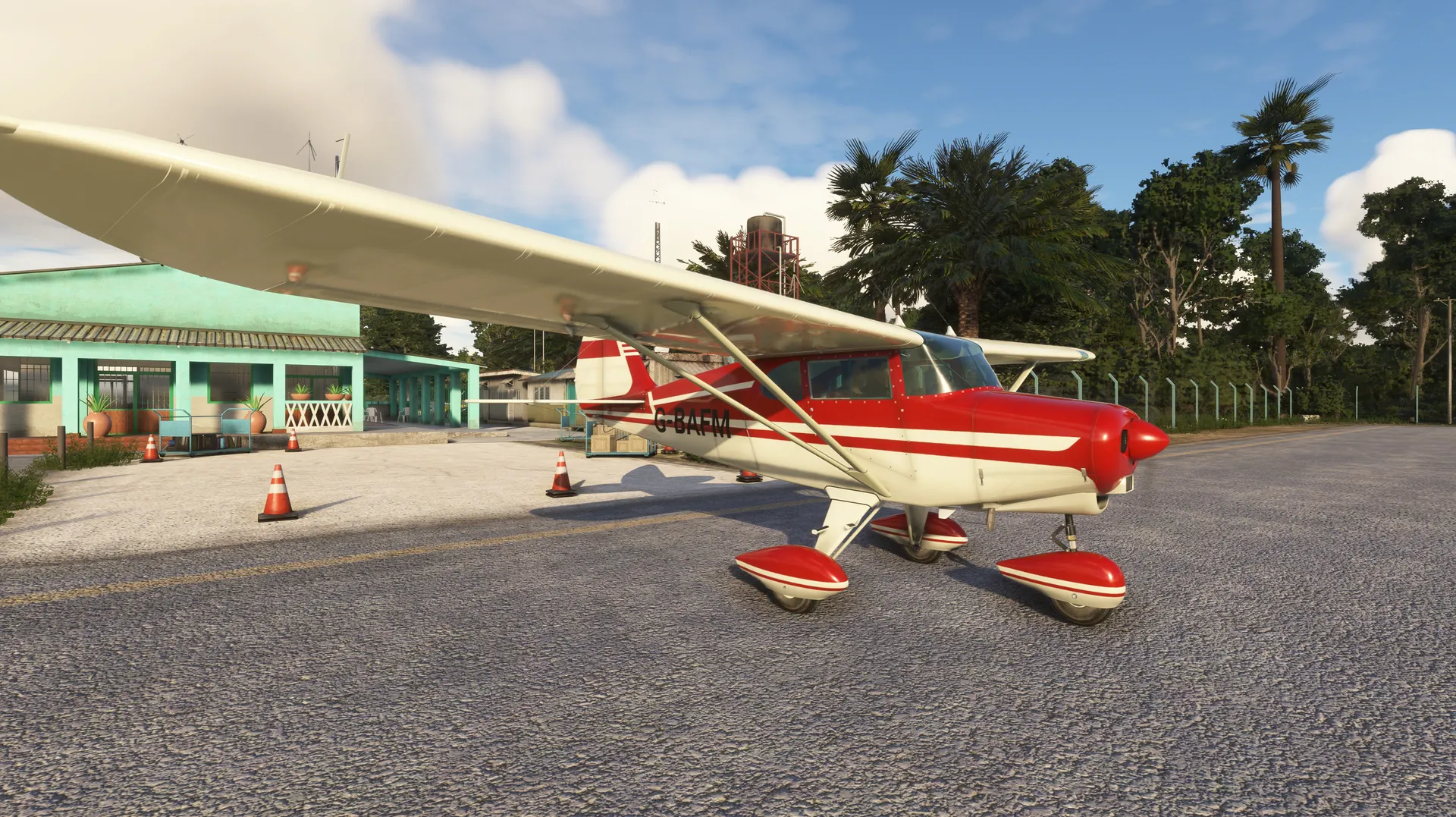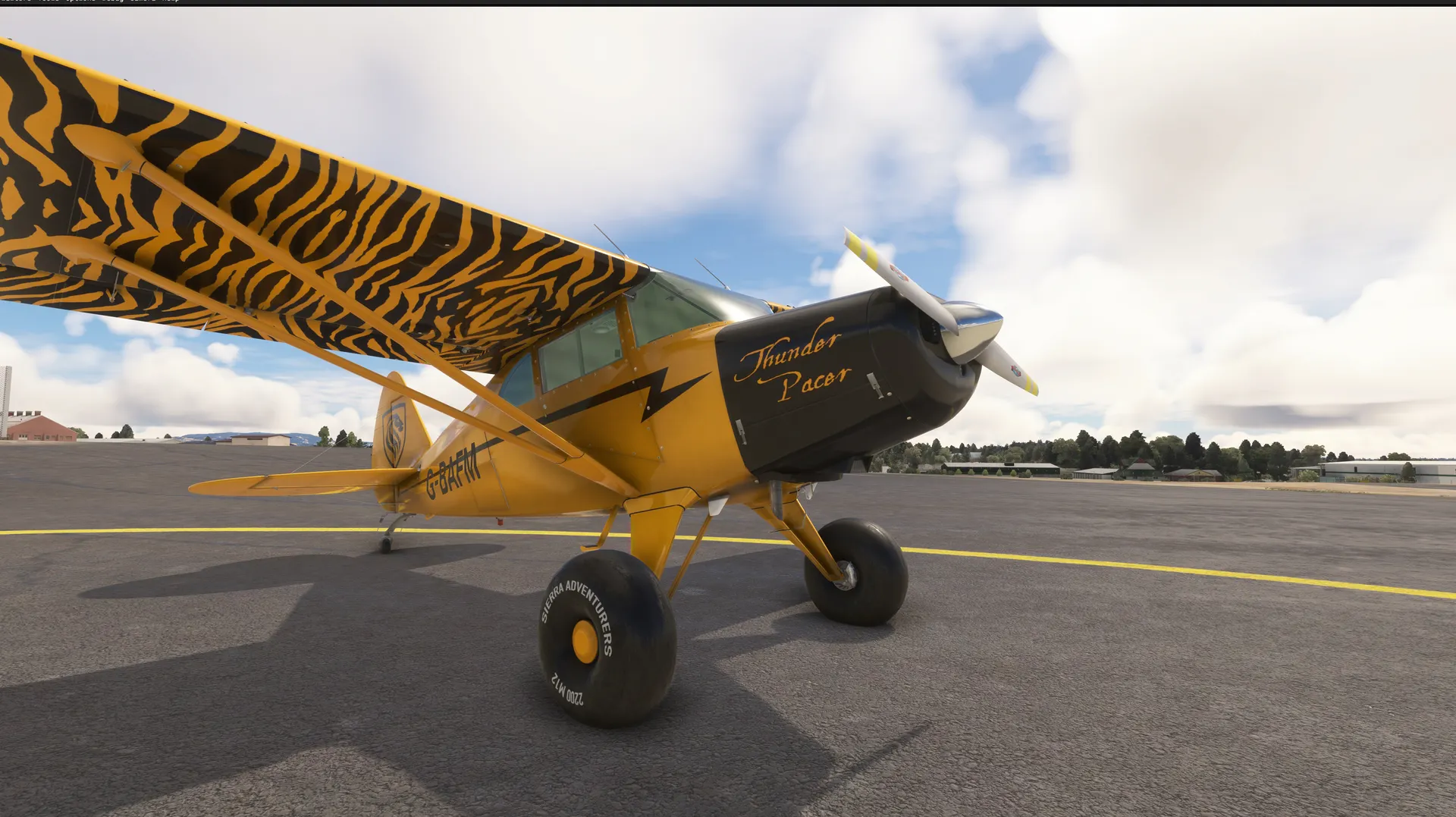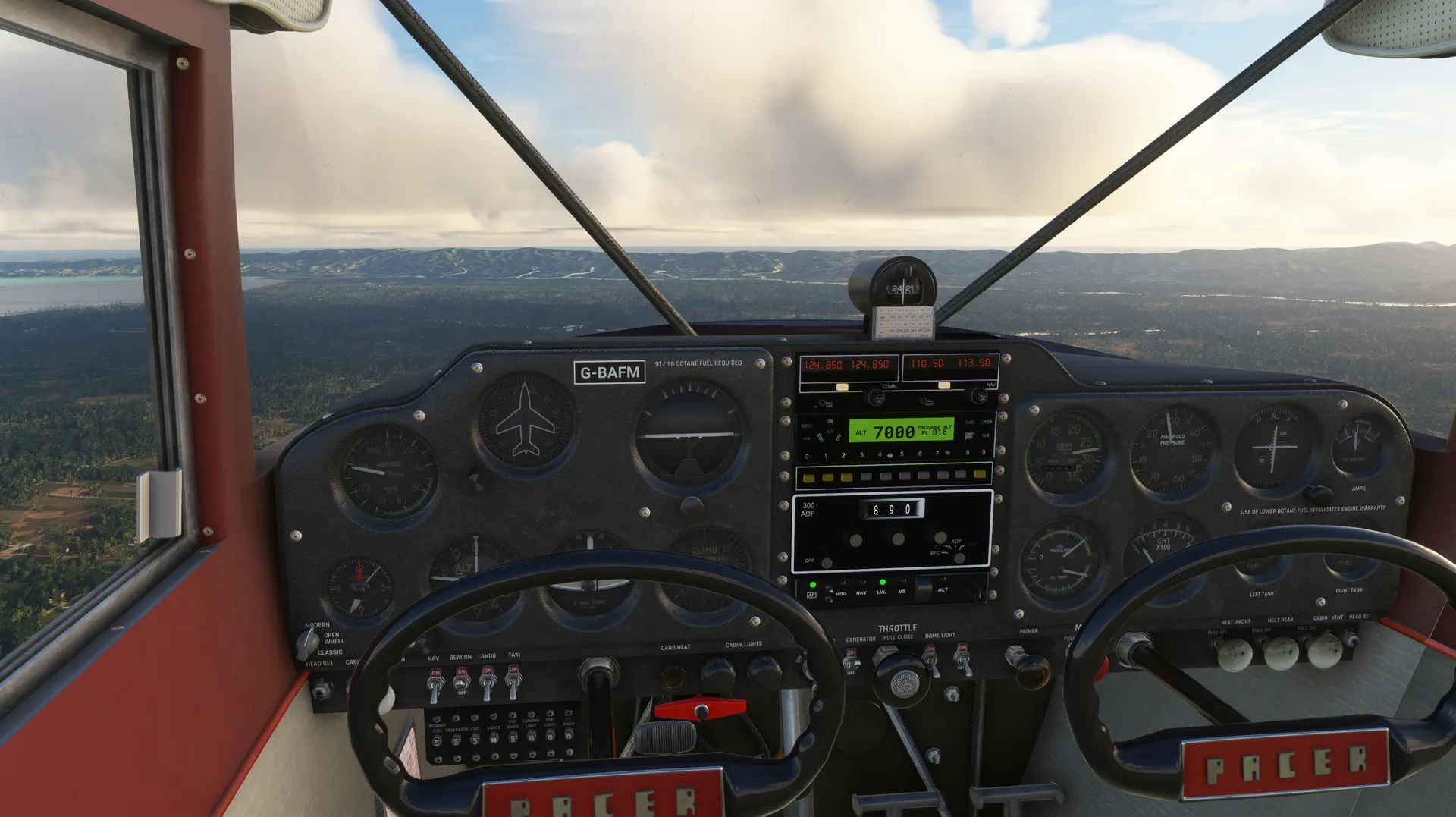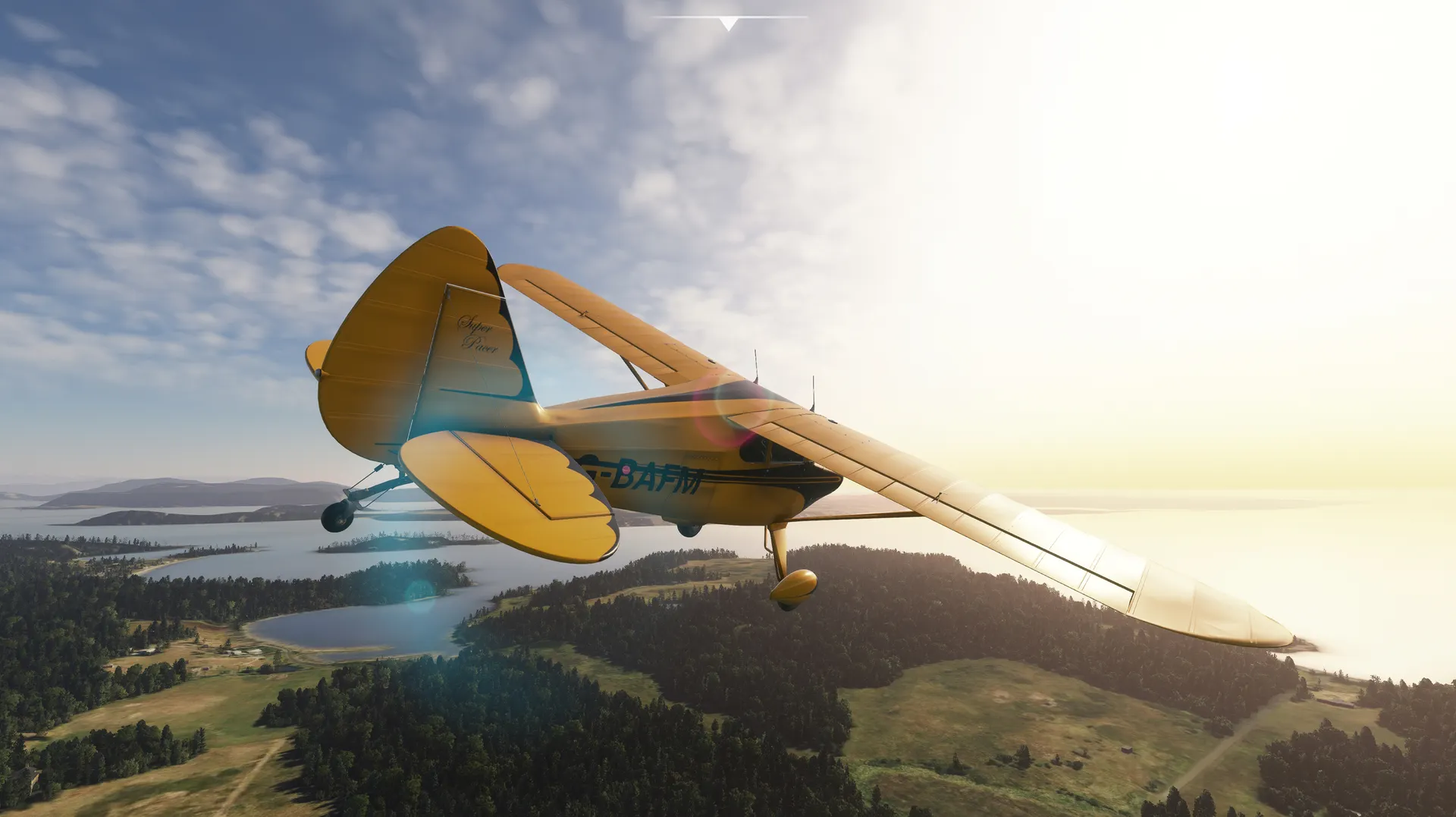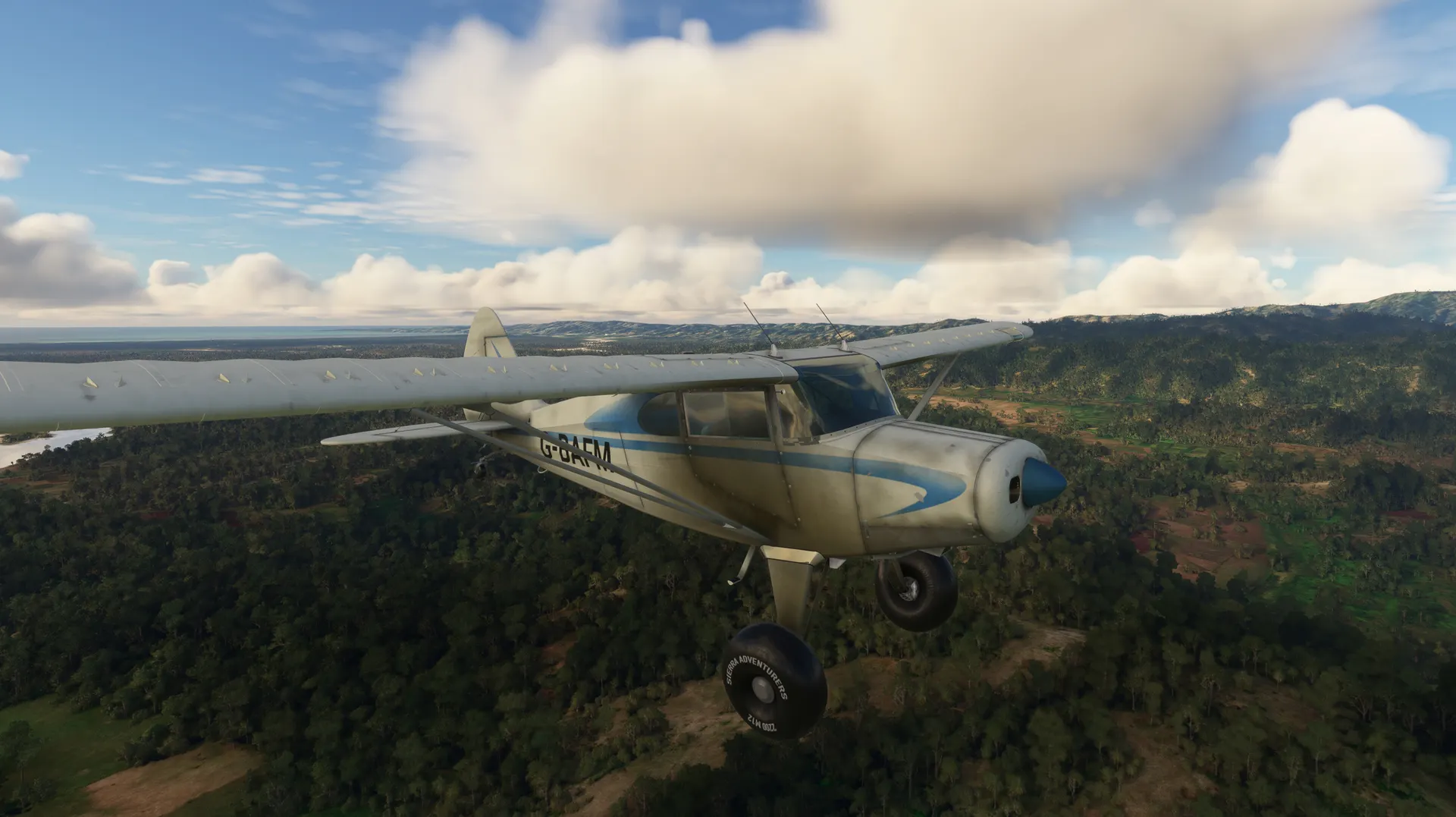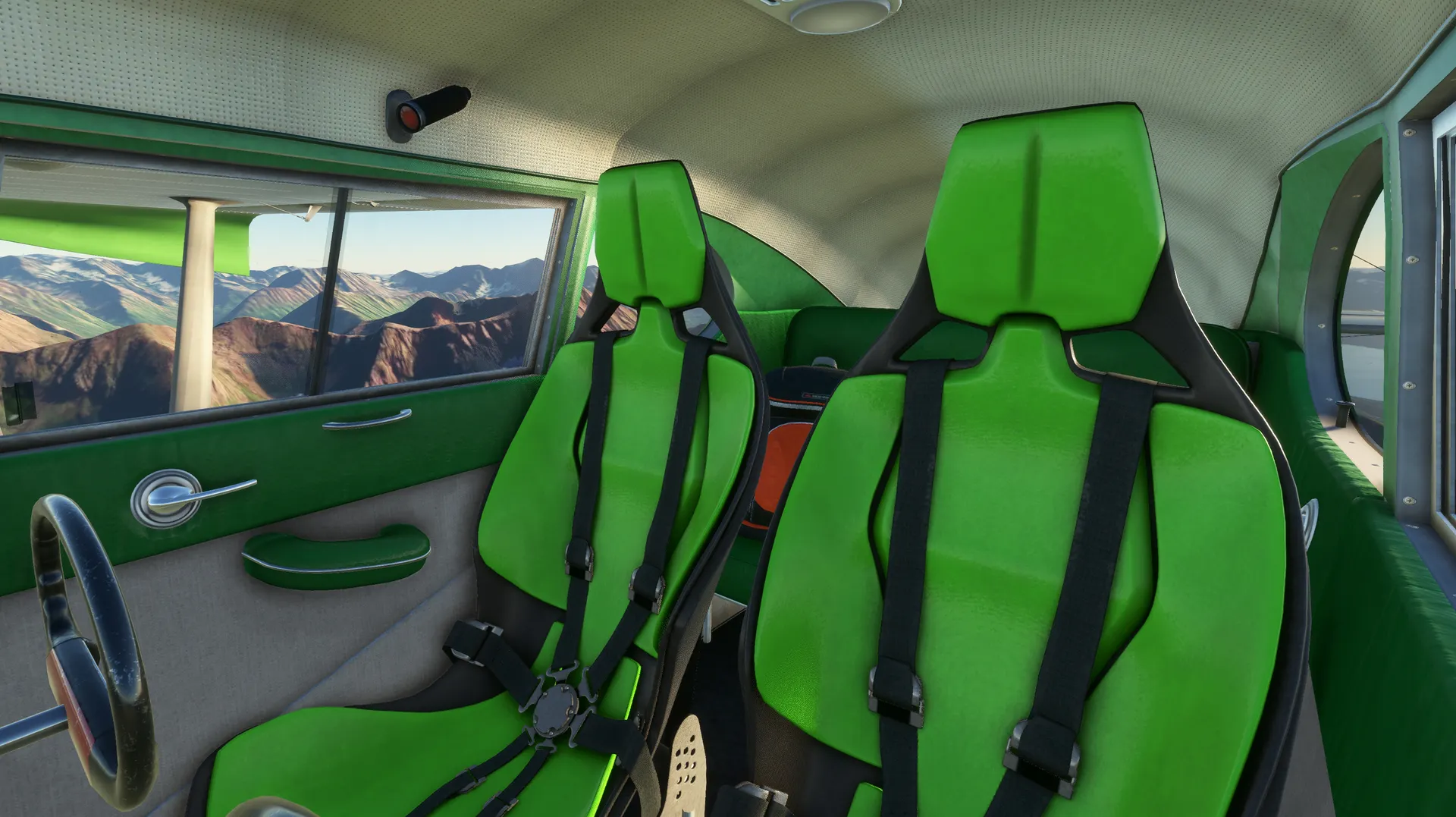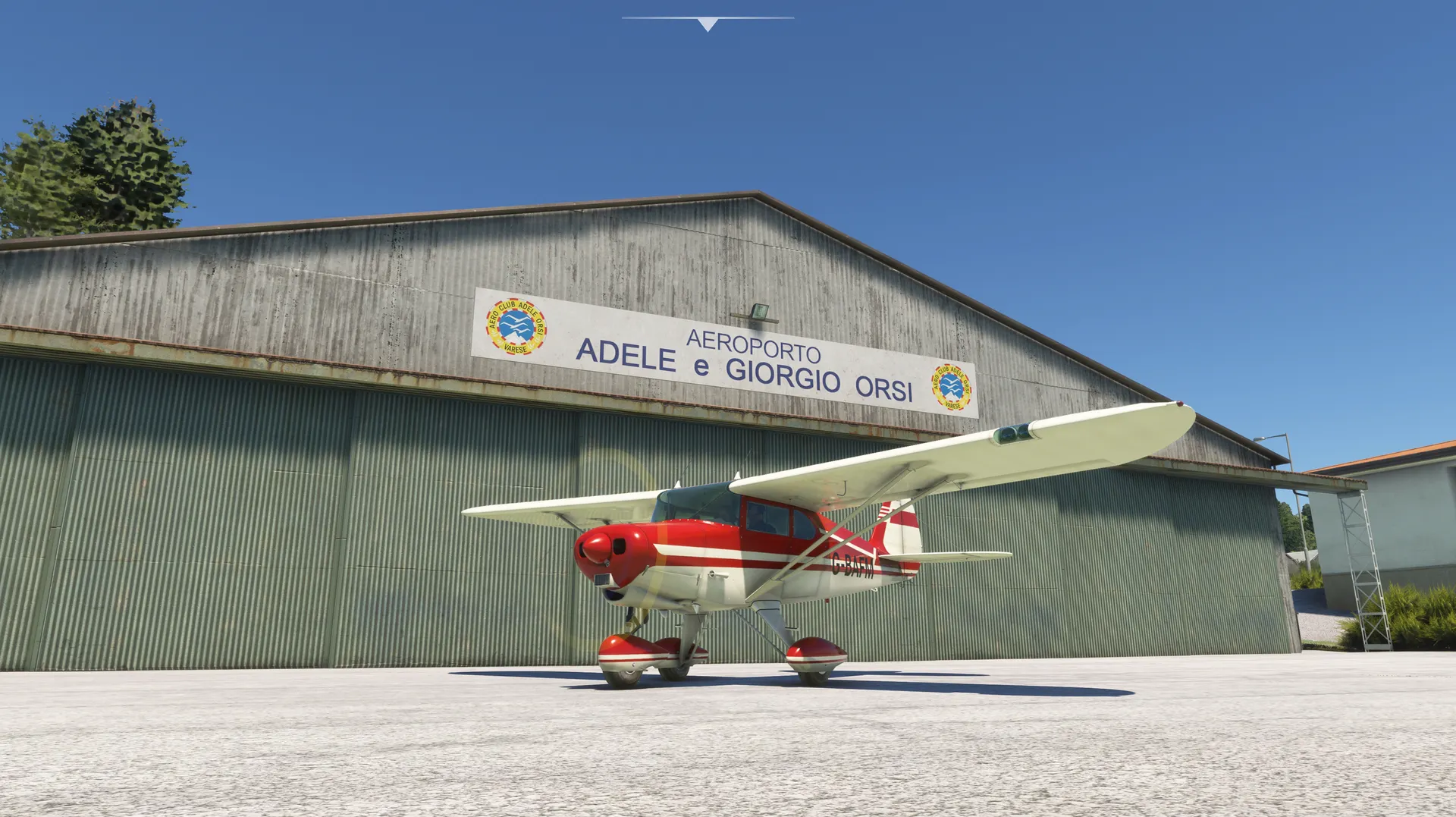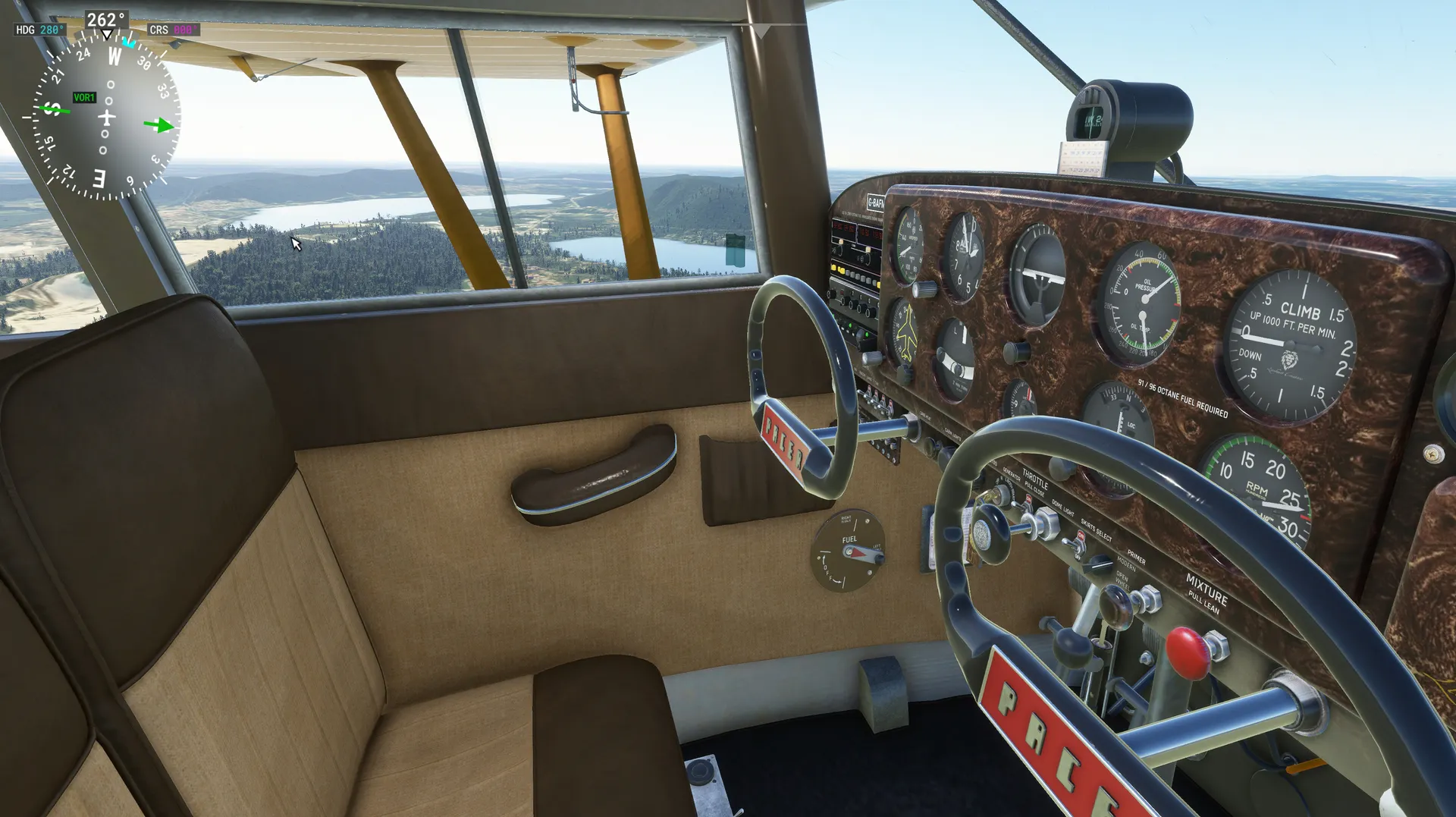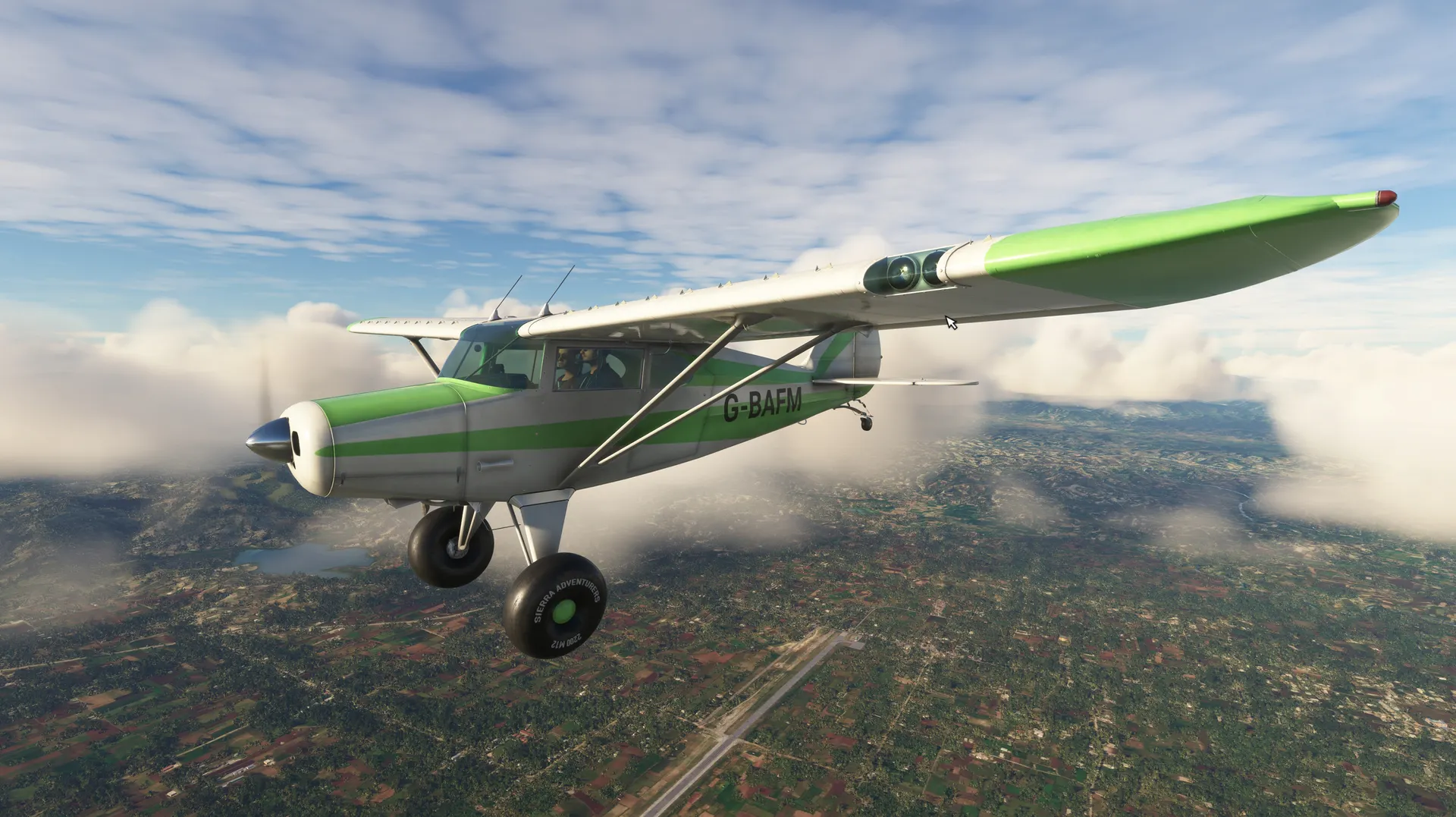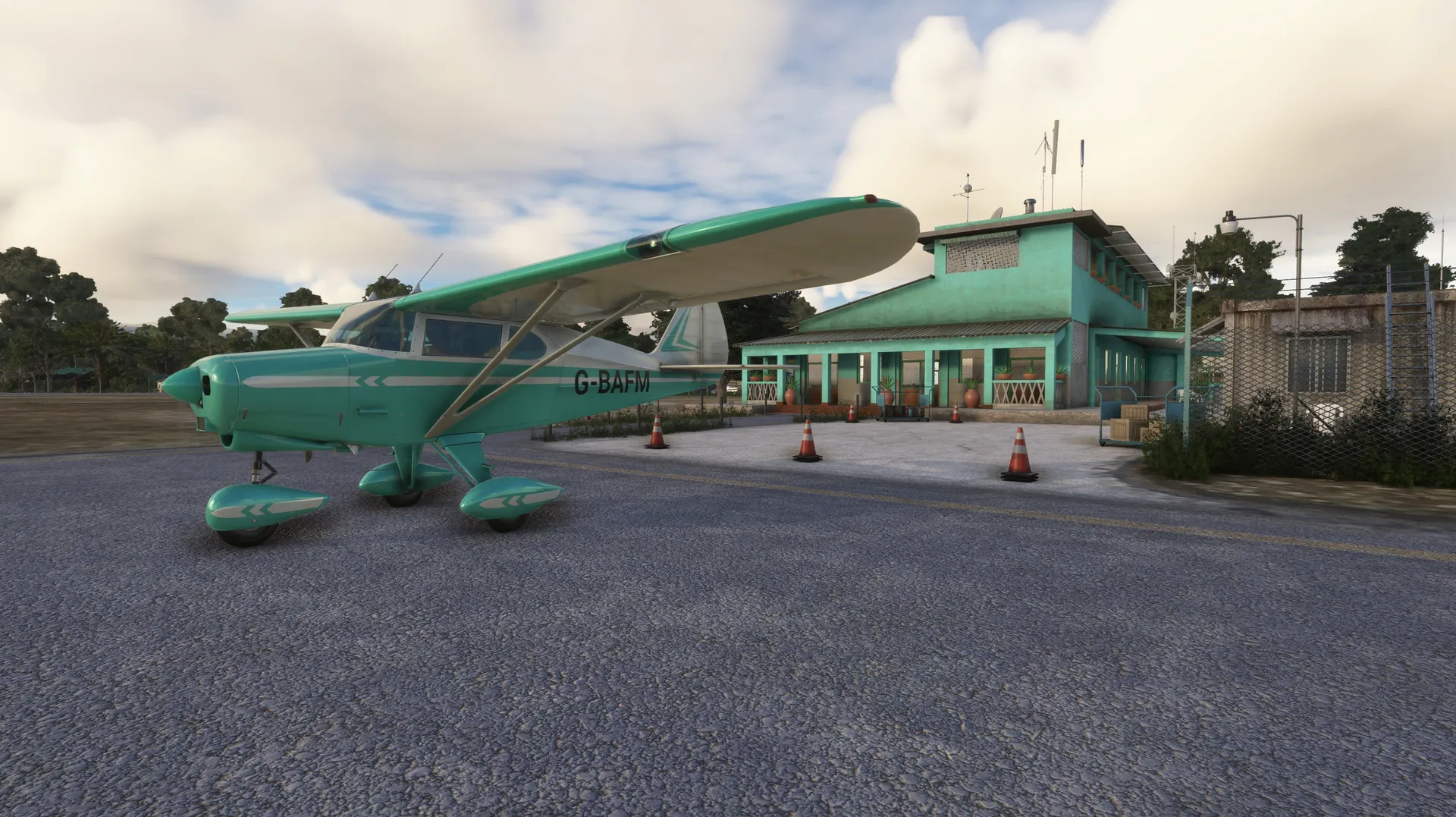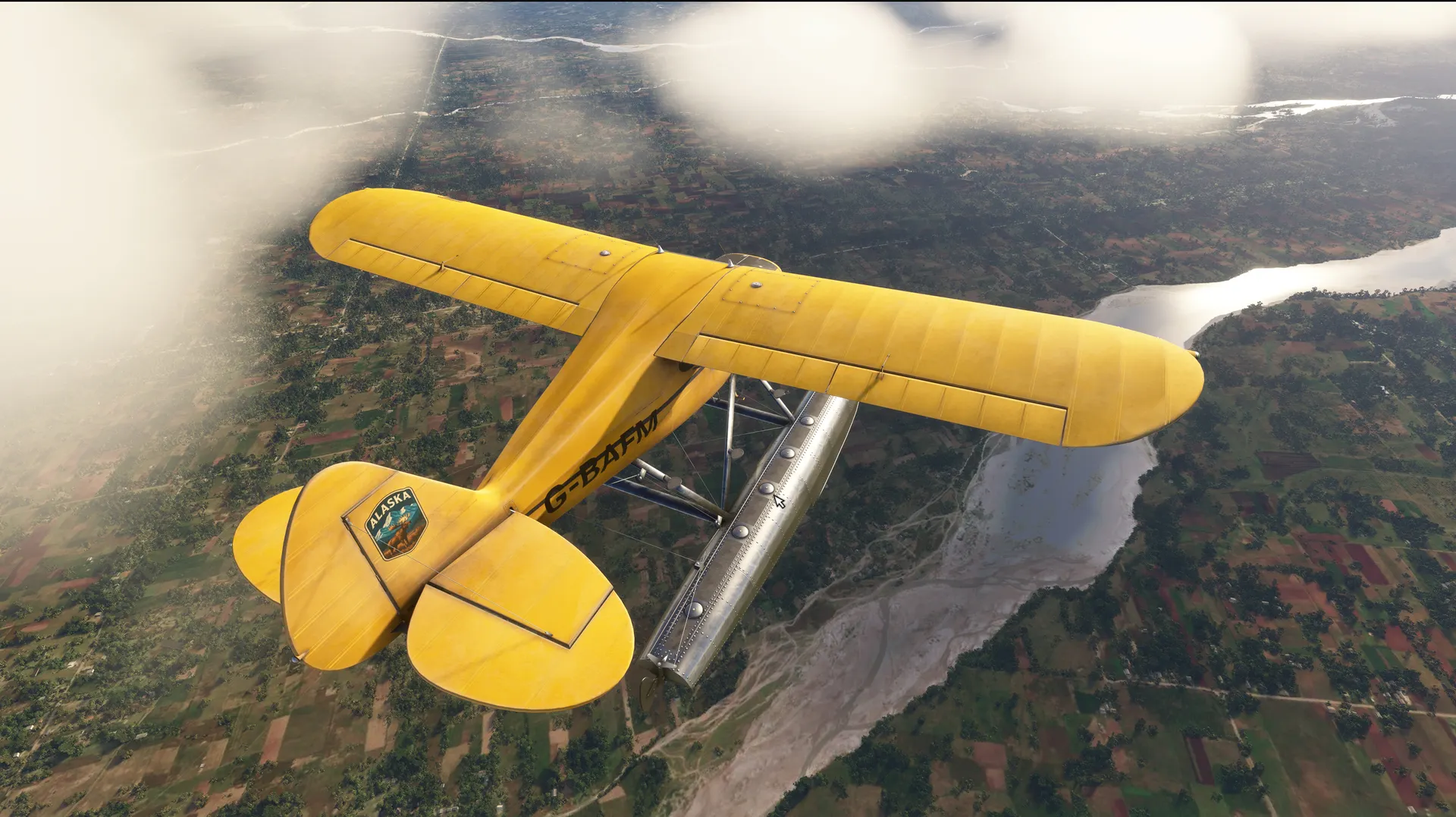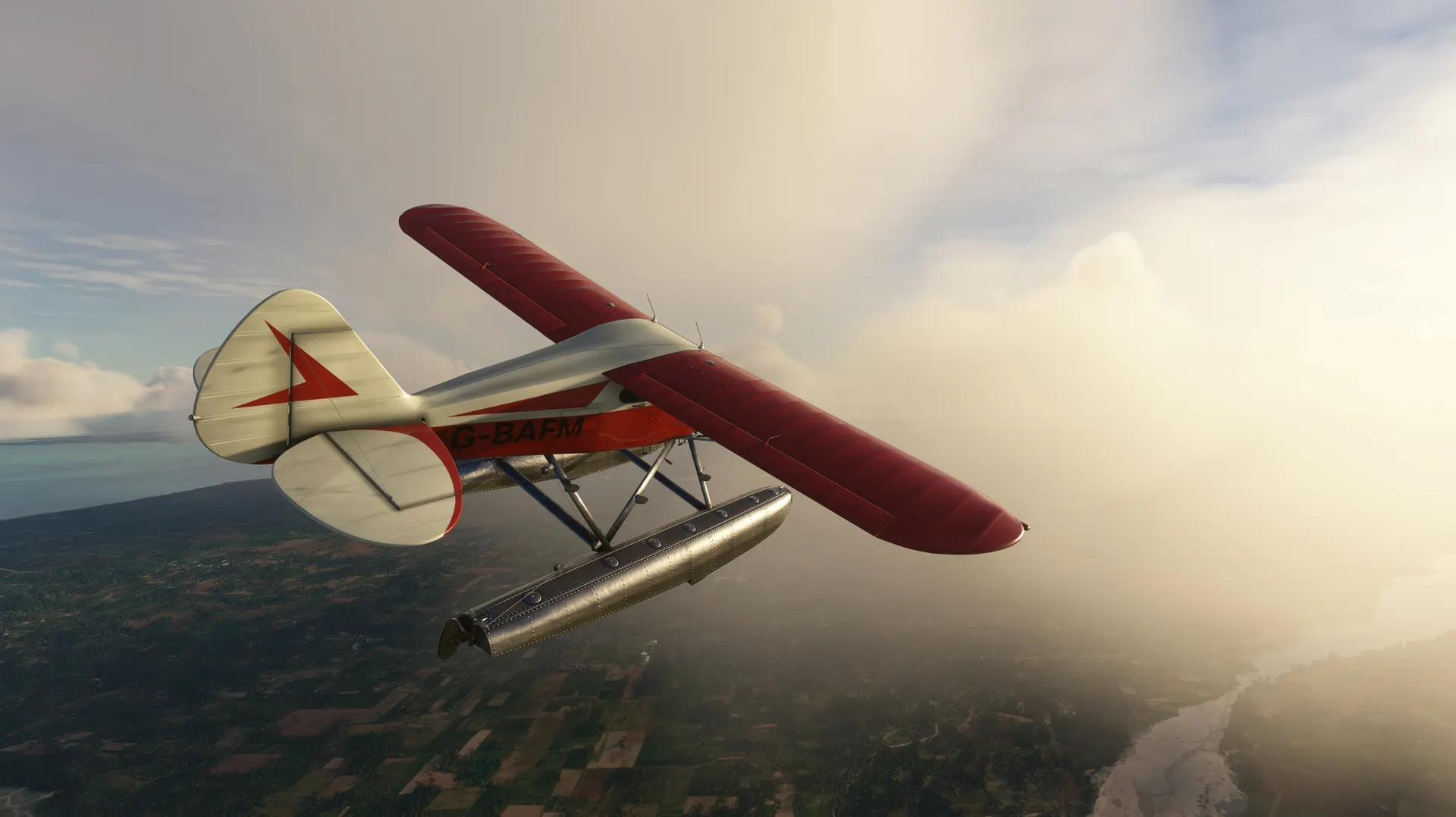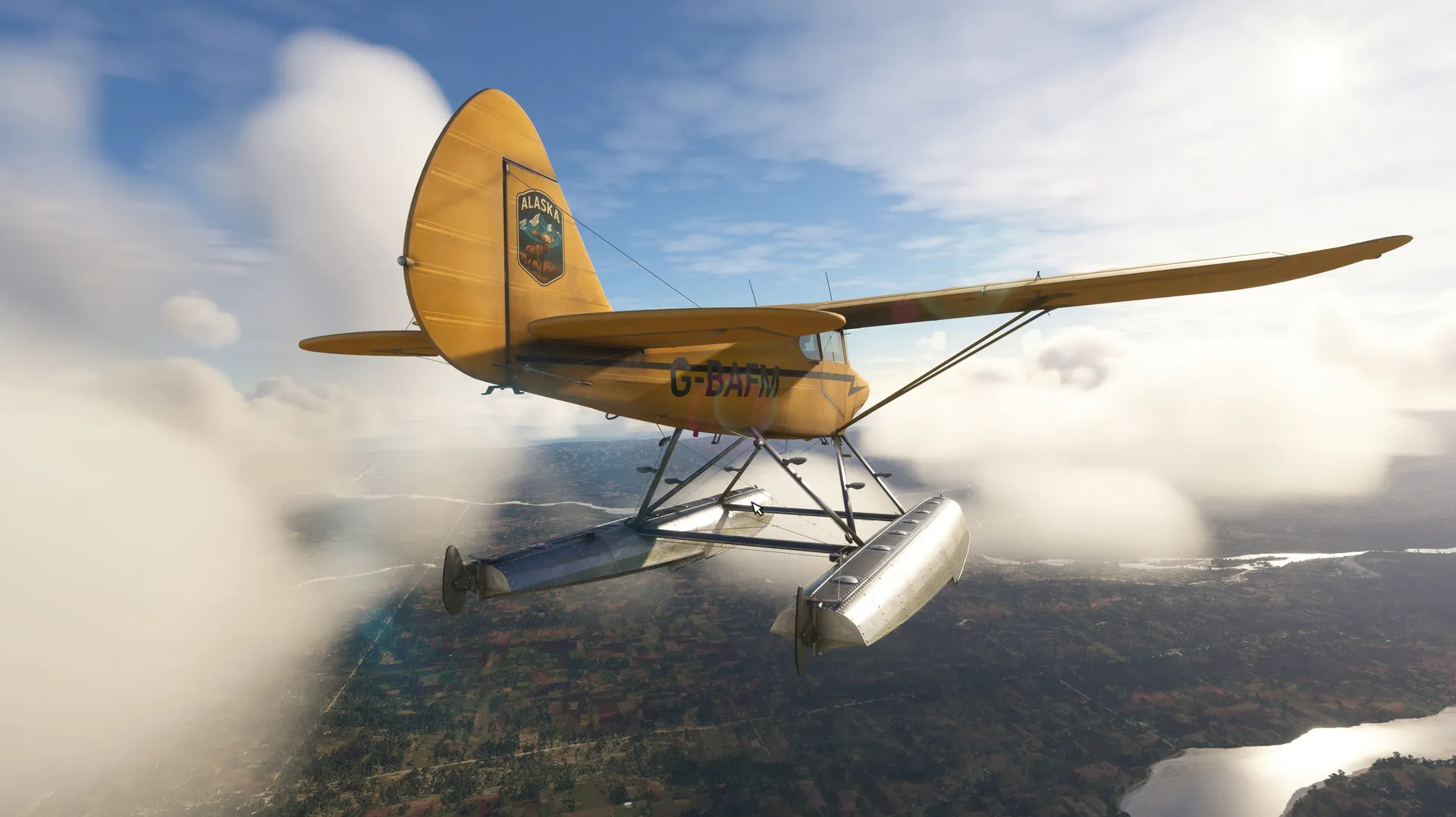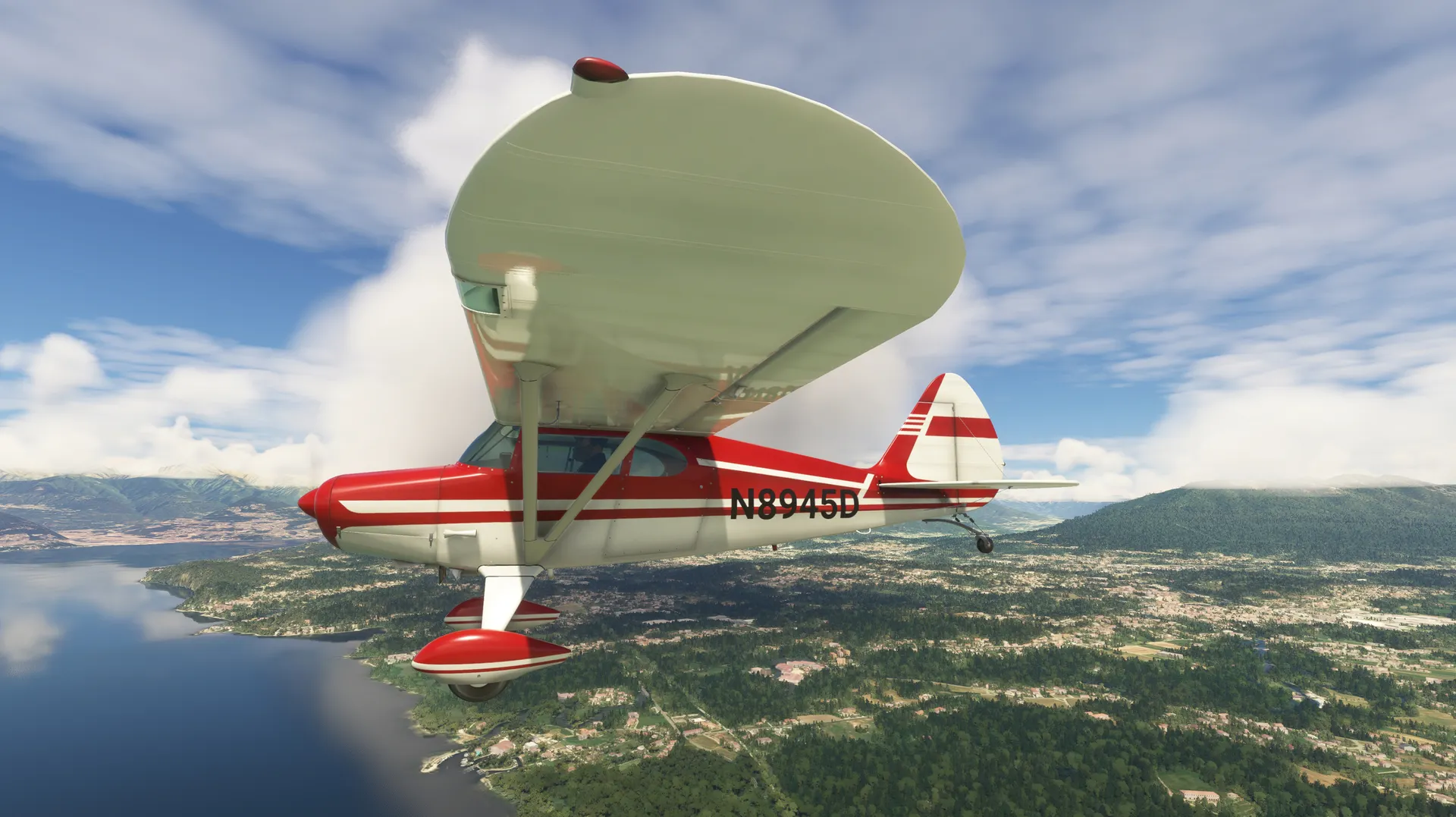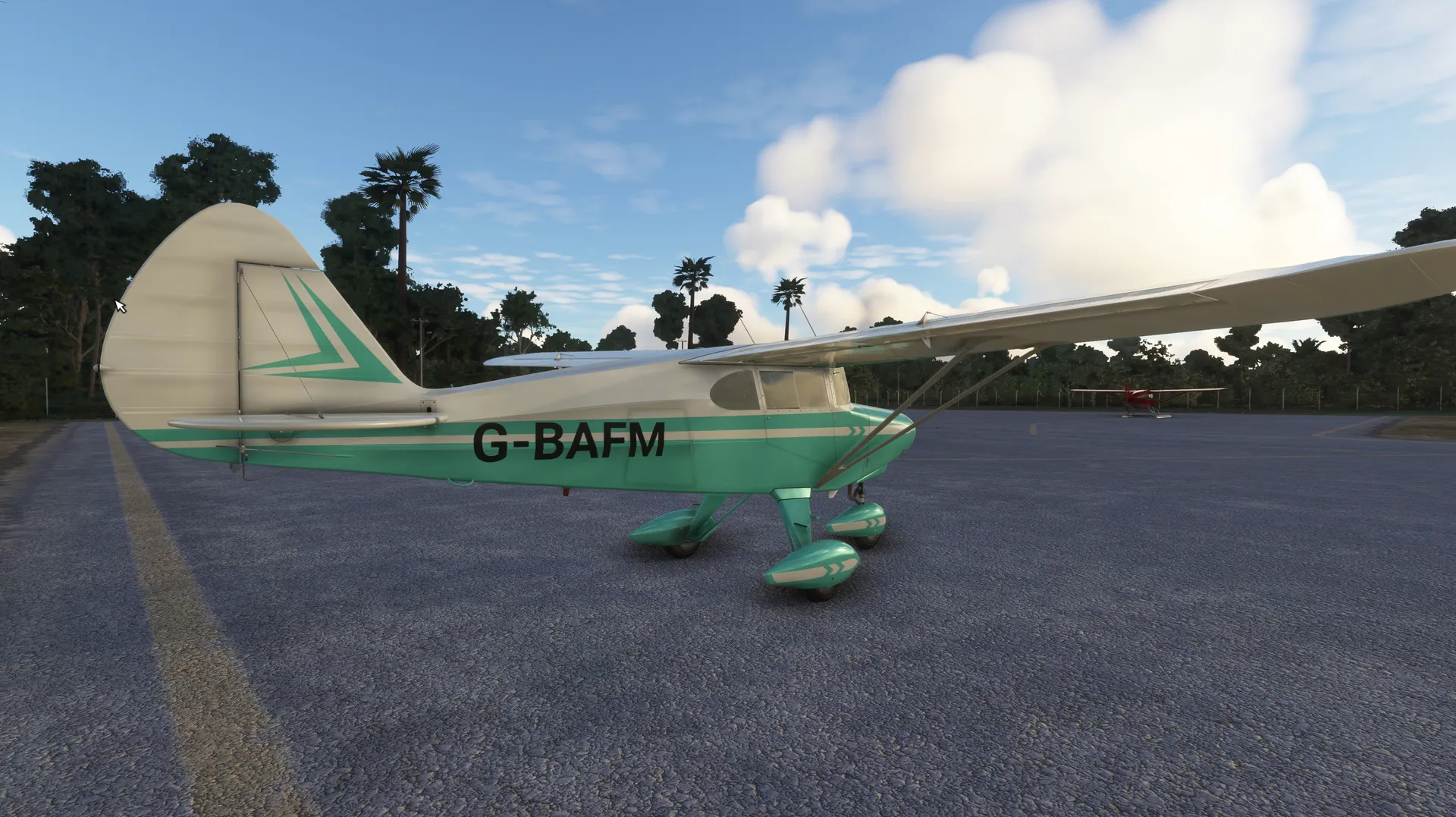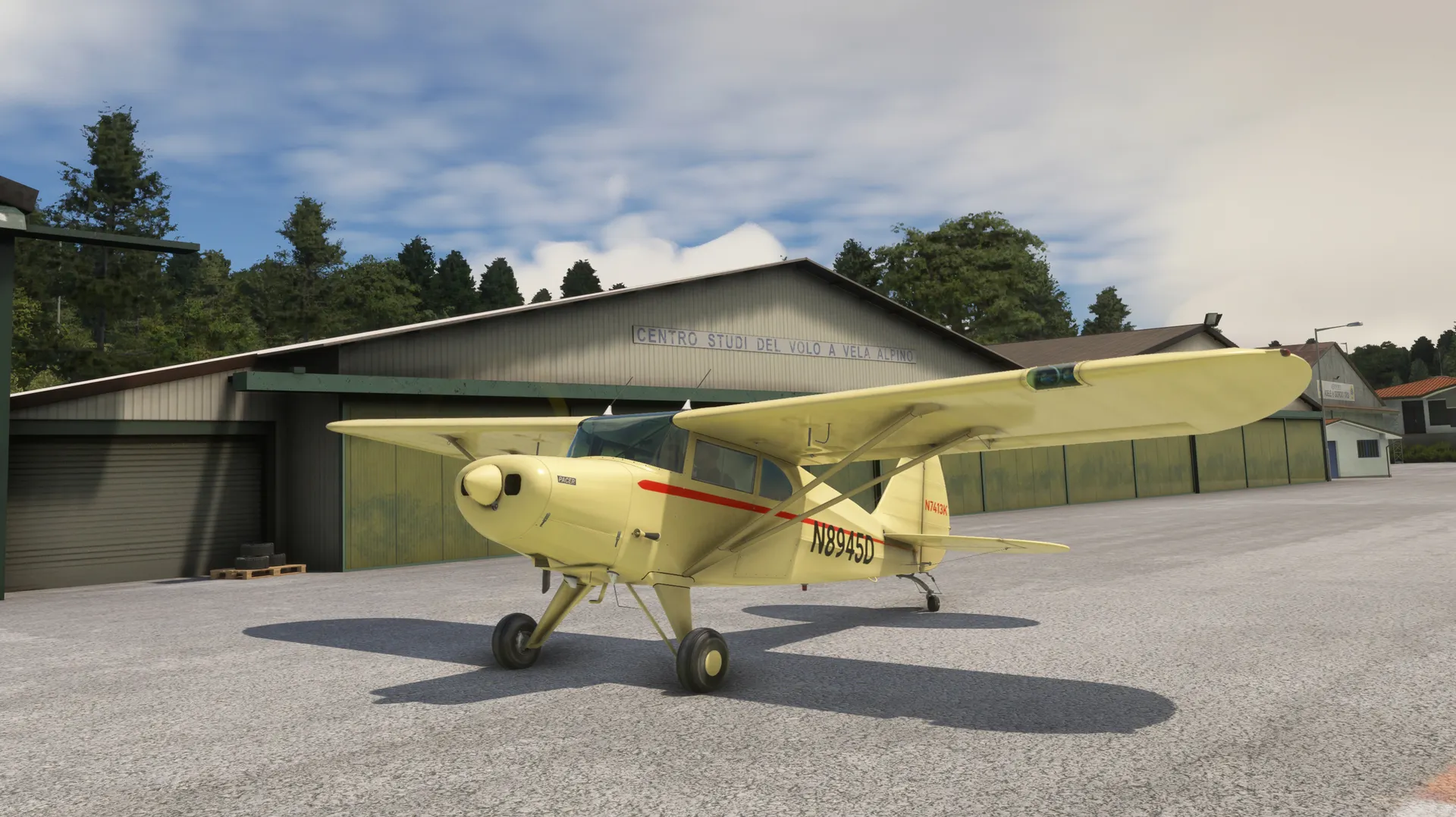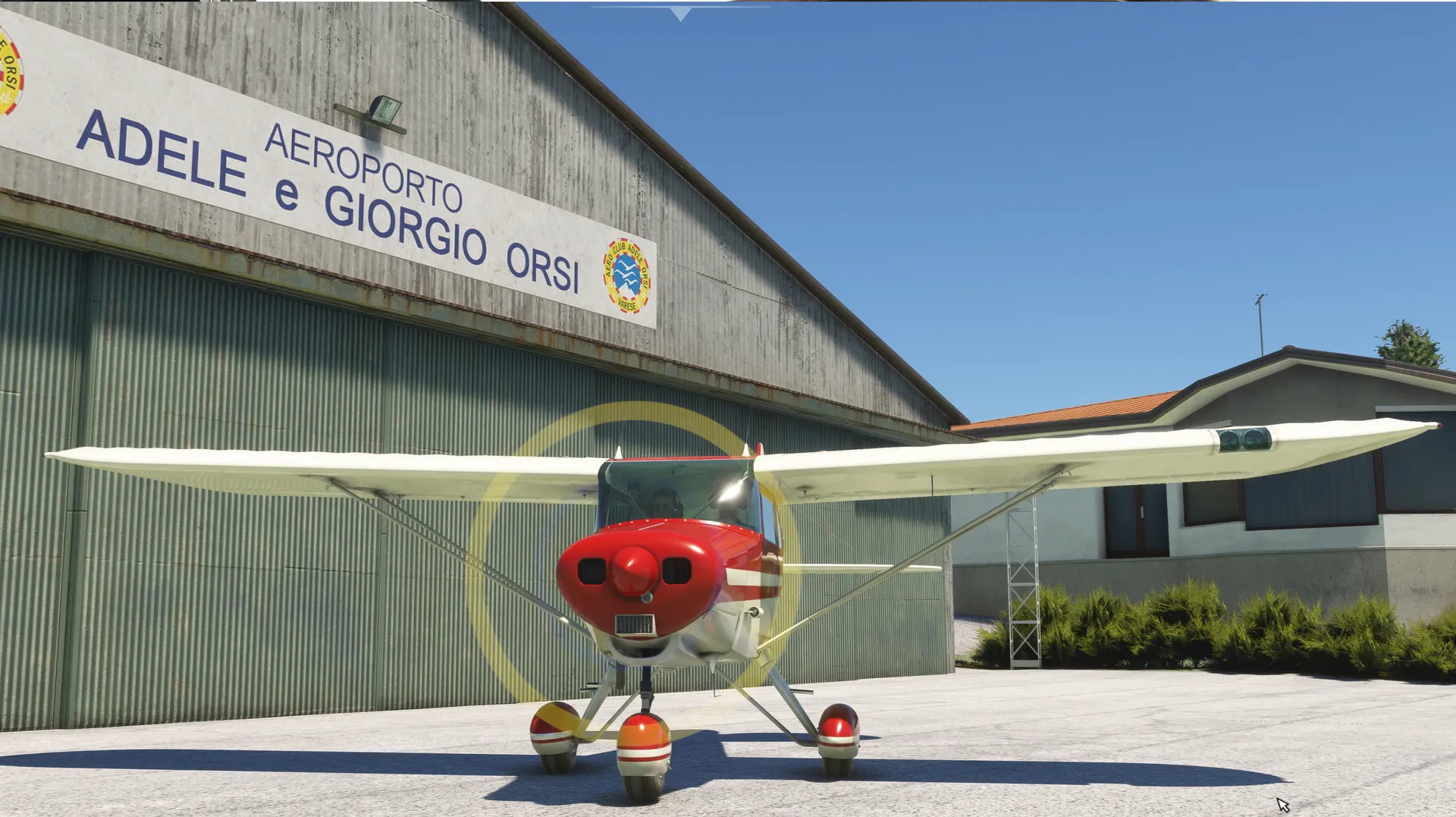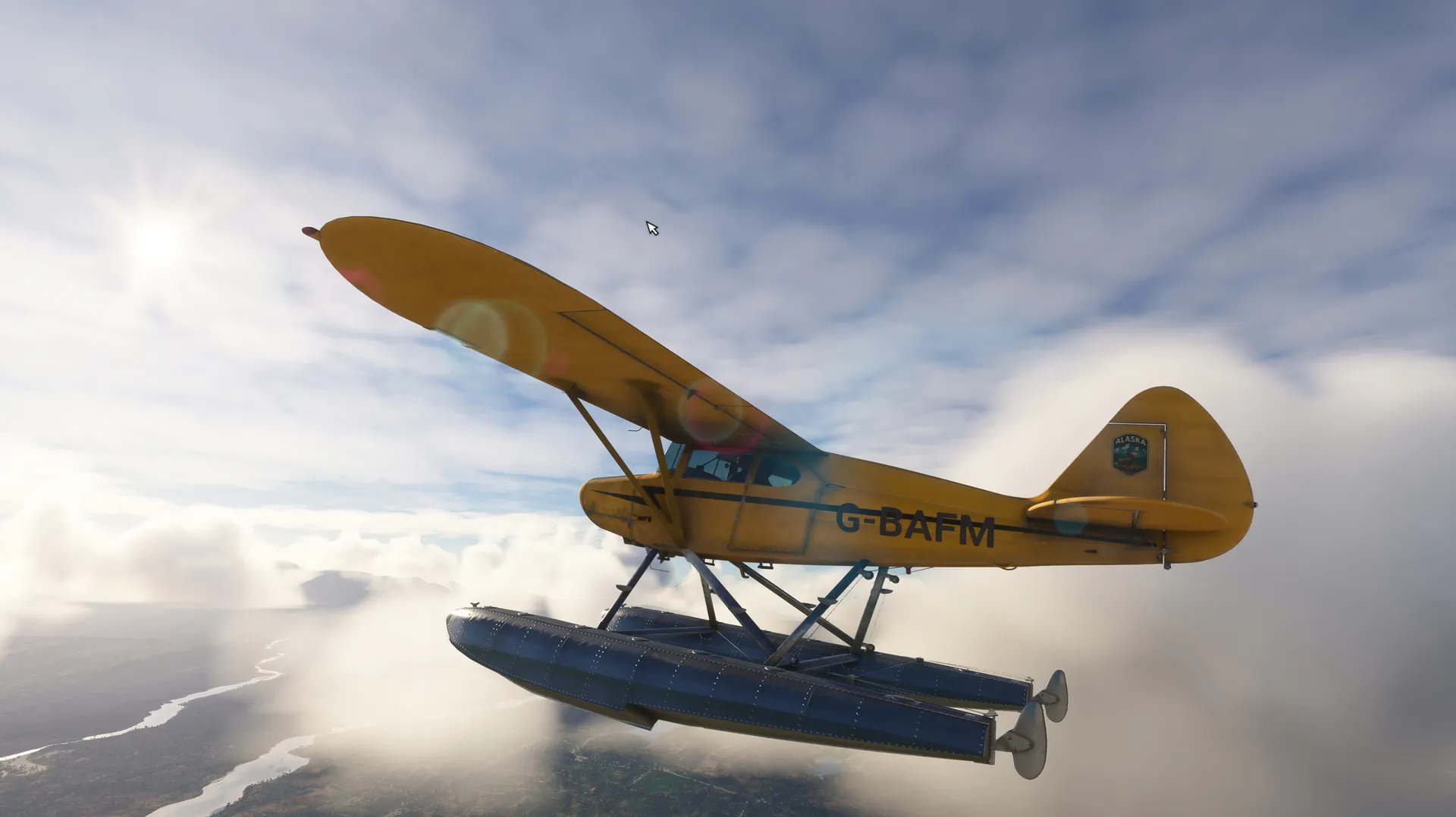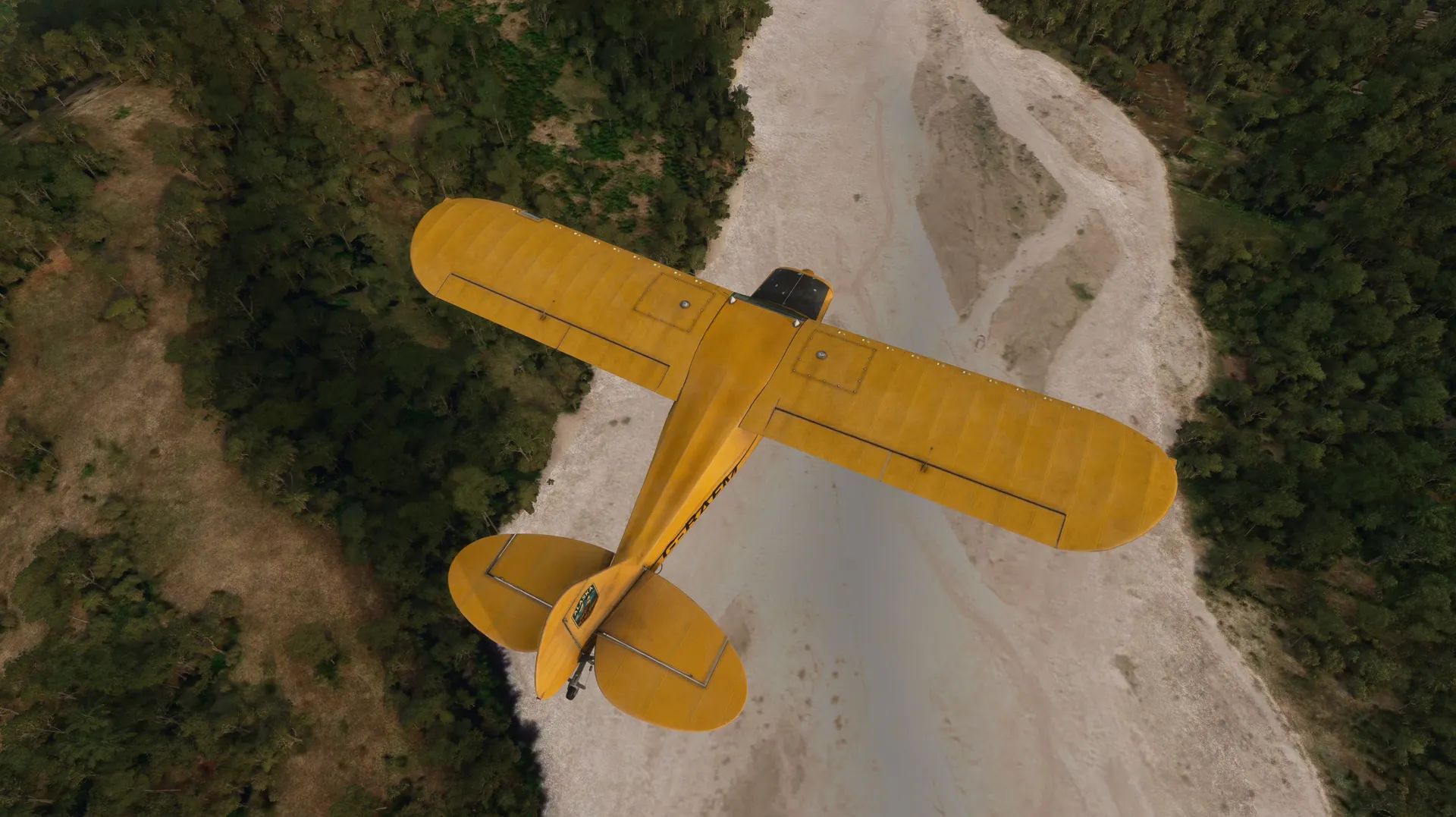VERSION 0.0.1 RELEASED MARCH 27, 2025
Prototype 001
5 Pacer Aircraft variants that feature 2 versions of instrument panels.
- Pacer 180
- Tripacer
- Bushplane
- Bushplane Special
- Floatplane
VERSION 0.0.2 RELEASED JULY 22, 2025
Fixes to textures and mesh
VERSION 0.0.3 RELEASED JULY 23, 2025
Prototype Build 0.0.3
- Redid a number of graphics updates on instrument panels
- Redid coding on Water Rudder and Gear controls for the FLoatplane variant.
VERSION 0.0.4 RELEASED JULY 24, 2025
Found 2 flaws in coding, repaired
Fixed some graphics issues that had sneaked through, repaired
VERSION 0.0.5 RELEASED JULY 30, 2025
Update to LOC files
VERSION 0.0.6 RELEASED AUGUST 7, 2025
Many small model updates to interior, fixes to sliding windows animations, various other updates.
VERSION 0.0.7 RELEASED AUGUST 8, 2025
Pre-Release Testing
- Adjustments to models, flight model configs,
- First prototype draft of the Owners Manual has been put into the package for review
- Adjustments to various parts of the package carried out.
VERSION 0.0.8 RELEASED AUGUST 11, 2025
Updates
- Updates to Checklists
- Updates to Textures, bugs found
- Updates to Manual
VERSION 1.0.0 RELEASED AUGUST 12, 2025
Released Build Update 1
- Updates to Textures
- Updates to Engine and Flight Model configs on Bushplane models for higher output and added lift from special wings and wingtip package and vortice tabs.
VERSION 1.0.1 RELEASED AUGUST 13, 2025
Updates
- Light switches on bush planes updated
- Special effects updates
- Fine tuning of flight models
- Mesh updates on interiors
VERSION 1.0.2 RELEASED JANUARY 1, 0
Update:
Fix to issue with planes groupings in MSFS 2024 which now separates the groups of Variants properly in MSFS 2024.
VERSION 1.0.3 RELEASED AUGUST 16, 2025
Update: 1.0.3
- Repair to the Aircraft Configs; Typo
VERSION 1.0.5 RELEASED SEPTEMBER 3, 2025
Update 1.0.5
First Release Update
- Tuning to Airspeeds throughout the package based on actual Pacer Pilots input
- TriPacer now adjusted to lower airspeeds for realism,
- Pacer 180 Taildraggers, non Bush, also reduced in airspeeds, 120 Knots at 2400 RPM
- Tuning to Propeller torque on roll, reduced as it was very high, difficult to counter
- Autopilot HDG setting now locks onto course you are on instead of existing settings such as 360 DEG
- Autopilot ALT now set to lock also when activated
- Skirt Stripes on Brown Stripes paint scheme are now on the correct side of the main skirts
- Repair to lower windscreen edge molding
- Addition of invisible Heading Adjustment Slider that comprizes of an invisible polygon over the Gyro Heading Instrument Face where you can mouse-drag-click on it and adjust your heading accordingly
- Adjustment of the standard pilots view height (non VR, normal only) on the TriPacer so that one is not too high in the view.
- Removal of bracket on rudder of TriPacer at the bottom of the rudder
- Removal of hand grips on tail on TriPacer
- White spot on the piping of the upholstery in the brown interiors is fixed, white spot is gone.
- Altimeter Disc BARO animation issue fixed on Classic Panel
- Fix to wrong nav lights showing on Bushplane Special, fixed
VERSION 1.0.6 RELEASED AUGUST 4, 2025
Update 1.0.6
First Release Update
- Tuning to Airspeeds throughout the package based on actual Pacer Pilots input
- TriPacer now adjusted to lower airspeeds for realism,
- Pacer 180 Taildraggers, non Bush, also reduced in airspeeds, 120 Knots at 2400 RPM
- Tuning to Propeller torque on roll, reduced as it was very high, difficult to counter
- Autopilot HDG setting now locks onto course you are on instead of existing settings such as 360 DEG
- Autopilot ALT now set to lock also when activated
- Skirt Stripes on Brown Stripes paint scheme are now on the correct side of the main skirts
- Repair to lower windscreen edge molding
- Addition of invisible Heading Adjustment Slider that comprizes of an invisible polygon over the Gyro Heading Instrument Face where you can mouse-drag-click on it and adjust your heading accordingly
- Adjustment of the standard pilots view height (non VR, normal only) on the TriPacer so that one is not too high in the view.
- Removal of bracket on rudder of TriPacer at the bottom of the rudder
- Removal of hand grips on tail on TriPacer
- White spot on the piping of the upholstery in the brown interiors is fixed, white spot is gone.
- Altimeter Disc BARO animation issue fixed on Classic Panel
- Fix to wrong nav lights showing on Bushplane Special, fixed
VERSION 1.0.7 RELEASED SEPTEMBER 11, 2025
UPDATE 2
Build 1.0.7
- Integration of Heading for Autopilot via mousing dragging over the top of the glass on the gyroscope Heading instrument. The mouse rect popup will reveal your HDG setting.
- Autopilot HDG now locks the HDG to active flight course as it should be
- New GPS Instrument added per requests of customers. This is the Asobo Aera Tablet, as like the FlightDesignCT and IconA5 have, but with a different casing that is aftermarket.
- New GPS now hides via clicking on the exterior temp instrument that lives up in the top right corner of the Perspex (windscreen)
- Adjustment to the rear Floatplane float struts, bringing the top mounts forward to the back framework zone in the fuselage/cabin area.
- Adjustment to animations in the Floatplane instrument panel Tri-Pacer style, fixing animations that werent working correctly.
- Mouse Rects Adjustments to Starter and Master Switch under Pilots seat
- Manual new edition PDF with updates
VERSION 1.3.0 RELEASED OCTOBER 20, 0
Updates for Pacer Release 3
New Build version is 1.3.0
Release Version 3
- Per Request: AP HDG Knob added to the Gyroscopic Compass
- Per Request: AP HDG Bug added to Gyroscopic Compass; Red color
- Per Request: Animated Toe Brakes added
- Gyro Compass 'Airplane' object changed to Yellow
- Per Feedback: The Interior Upholstery redone, rebuilt and reshaped mesh added and features PBR pure 3D leather and fabric throughout the interior sides and seats including wrinkles and details in the leathers and fabrics.
- Rear cargo area upper top removed to resemble the back interior 'trunk' or 'boot' area better.
- Rear cargo area redone around door edges / sill structure to look cleaner and realistic
- Rear cargo area: Antique crate in cargo boot with oil cans and plexi cleaner in it
- New Radical Sport Seats in Bush Plane Special fitted
- Map pocket at pilots side panel area added
- Float Plane Gear and Rudder Controls now hidden on planes that are in non-float-plane status
- Under Panel Yoke Controls Chain Tunner tower (black tube in center under panel) is now animating properly, moves fore and aft with yoke fore-aft input
- VR View Point tuned and adjusted
VERSION 1.3.1 RELEASED OCTOBER 22, 2025
Updates for Pacer Release 3
New Build version is 1.3.0
Release Version 3
- Per Request: AP HDG Knob added to the Gyroscopic Compass
- Per Request: AP HDG Bug added to Gyroscopic Compass; Red color
- Per Request: Animated Toe Brakes added
- Gyro Compass 'Airplane' object changed to Yellow. This helps with seeing the numbers better on the compass disc when the plane is overlapping them in the instrument
- Per Feedback: The Interior Upholstery has been redone, rebuilt and reshaped mesh added and features PBR pure 3D leather and fabric throughout the interior sides and seats including wrinkles and details in the leathers and fabrics.
- Rear cargo area upper top removed to resemble the back interior 'trunk' or 'boot' area better.
- Rear cargo area redone around door edges / sill structure to look cleaner and realistic
- Rear cargo area: Antique crate in cargo boot with oil cans and plexi cleaner in it
- New Radical Sport Seats in Bush Plane Special fitted
- Map pocket at pilots side panel area added
- Float Plane Gear and Rudder Controls now hidden on planes that are in non-float-plane status
- Under Panel Yoke Controls Chain Tunner tower (black tube in center under panel) is now animating properly, moves fore and aft with yoke fore-aft input
- VR View Point tuned and adjusted
- Door Latches and Latch Collars given new materials
- Instrument panels enhanced on some planes, with one Burled Wood added.
- Fuel Selector Panel (Round) and overhead Elevator Trim panel have been retextured with PBR materials and hovering Asobo fonts for extreme clarity as like the panels
- Yellow Bullet Livery Package recieved a Burled Wood modification to the instrument panel facia that looks awesome
VERSION 1.3.2 RELEASED JANUARY 1, 0
Updates for Pacer Release 3
New Build version is 1.3.2
Release Version 3
- Per Request: AP HDG Knob added to the Gyroscopic Compass
- Per Request: AP HDG Bug added to Gyroscopic Compass; Red color
- Per Request: Animated Toe Brakes added
- Gyro Compass 'Airplane' object changed to Yellow. This helps with seeing the numbers better on the compass disc when the plane is overlapping them in the instrument
- Per Feedback: The Interior Upholstery has been redone, rebuilt and reshaped mesh added and features PBR pure 3D leather and fabric throughout the interior sides and seats including wrinkles and details in the leathers and fabrics.
- Rear cargo area upper top removed to resemble the back interior 'trunk' or 'boot' area better.
- Rear cargo area redone around door edges / sill structure to look cleaner and realistic
- Rear cargo area: Antique crate in cargo boot with oil cans and plexi cleaner in it
- New Radical Sport Seats in Bush Plane Special fitted
- Map pocket at pilots side panel area added
- Float Plane Gear and Rudder Controls now hidden on planes that are in non-float-plane status
- Under Panel Yoke Controls Chain Tunner tower (black tube in center under panel) is now animating properly, moves fore and aft with yoke fore-aft input
- VR View Point tuned and adjusted
- Door Latches and Latch Collars given new materials
- Instrument panels enhanced on some planes, with one Burled Wood added.
- Fuel Selector Panel (Round) and overhead Elevator Trim panel have been retextured with PBR materials and hovering Asobo fonts for extreme clarity as like the panels
- Yellow Bullet Livery Package recieved a Burled Wood modification to the instrument panel facia that looks awesome
VERSION 1.3.3 RELEASED OCTOBER 31, 2025
Updates for Pacer Release 3
New Build version is 1.3.3
Release Version 3
- Per Request: AP HDG Knob added to the Gyroscopic Compass
- Per Request: AP HDG Bug added to Gyroscopic Compass; Red color
- Per Request: Animated Toe Brakes added
- Gyro Compass 'Airplane' object changed to Yellow. This helps with seeing the numbers better on the compass disc when the plane is overlapping them in the instrument
- Per Feedback: The Interior Upholstery has been redone, rebuilt and reshaped mesh added and features PBR pure 3D leather and fabric throughout the interior sides and seats including wrinkles and details in the leathers and fabrics.
- Rear cargo area upper top removed to resemble the back interior 'trunk' or 'boot' area better.
- Rear cargo area redone around door edges / sill structure to look cleaner and realistic
- Rear cargo area: Antique crate in cargo boot with oil cans and plexi cleaner in it
- New Radical Sport Seats in Bush Plane Special fitted
- Map pocket at pilots side panel area added
- Float Plane Gear and Rudder Controls now hidden on planes that are in non-float-plane status
- Under Panel Yoke Controls Chain Tunner tower (black tube in center under panel) is now animating properly, moves fore and aft with yoke fore-aft input
- VR View Point tuned and adjusted
- Door Latches and Latch Collars given new materials
- Instrument panels enhanced on some planes, with one Burled Wood added.
- Fuel Selector Panel (Round) and overhead Elevator Trim panel have been retextured with PBR materials and hovering Asobo fonts for extreme clarity as like the panels
- Yellow Bullet Livery Package recieved a Burled Wood modification to the instrument panel facia that looks awesome
- PBR Material Tech applied to Nap Sack (Pilots Bag in back)
VERSION 1.3.4 RELEASED NOVEMBER 3, 2025
Updates for Pacer Release 3
New Build version is 1.3.4
Release Version 3
- Per Request: AP HDG Knob added to the Gyroscopic Compass
- Per Request: AP HDG Bug added to Gyroscopic Compass; Red color
- Per Request: Animated Toe Brakes added
- Gyro Compass 'Airplane' object changed to Yellow. This helps with seeing the numbers better on the compass disc when the plane is overlapping them in the instrument
- Per Feedback: The Interior Upholstery has been redone, rebuilt and reshaped mesh added and features PBR pure 3D leather and fabric throughout the interior sides and seats including wrinkles and details in the leathers and fabrics.
- Rear cargo area upper top removed to resemble the back interior 'trunk' or 'boot' area better.
- Rear cargo area redone around door edges / sill structure to look cleaner and realistic
- Rear cargo area: Antique crate in cargo boot with oil cans and plexi cleaner in it
- New Radical Sport Seats in Bush Plane Special fitted
- Map pocket at pilots side panel area added
- Float Plane Gear and Rudder Controls now hidden on planes that are in non-float-plane status
- Under Panel Yoke Controls Chain tower (black tube in center under panel) is now animating properly, moves fore and aft with yoke fore-aft input
- VR View Point tuned and adjusted
- Door Latches and Latch Collars given new materials
- Instrument panels enhanced on some planes, with one Burled Wood added.
- Fuel Selector Panel (Round) and overhead Elevator Trim panel have been retextured with PBR materials and hovering Asobo fonts for extreme clarity as like the panels
- Yellow Bullet Livery Package received a Burled Wood modification to the instrument panel facia that looks awesome
- PBR Material Tech applied to Nap Sack (Pilots Bag in back)
- Classic Panel Dimming System coding changed
VERSION 1.3.5 RELEASED NOVEMBER 4, 2025
Updates for Pacer Release 3
New Build version is 1.3.5
Release Version 3
- Per Request: AP HDG Knob added to the Gyroscopic Compass
- Per Request: AP HDG Bug added to Gyroscopic Compass; Red color
- Per Request: Animated Toe Brakes added
- Gyro Compass 'Airplane' object changed to Yellow. This helps with seeing the numbers better on the compass disc when the plane is overlapping them in the instrument
- Per Feedback: The Interior Upholstery has been redone, rebuilt and reshaped mesh added and features PBR pure 3D leather and fabric throughout the interior sides and seats including wrinkles and details in the leathers and fabrics.
- Rear cargo area upper top removed to resemble the back interior 'trunk' or 'boot' area better.
- Rear cargo area redone around door edges / sill structure to look cleaner and realistic
- Rear cargo area: Antique crate in cargo boot with oil cans and plexi cleaner in it
- New Radical Sport Seats in Bush Plane Special fitted
- Map pocket at pilots side panel area added
- Float Plane Gear and Rudder Controls now hidden on planes that are in non-float-plane status
- Under Panel Yoke Controls Chain tower (black tube in center under panel) is now animating properly, moves fore and aft with yoke fore-aft input
- VR View Point tuned and adjusted
- Door Latches and Latch Collars given new materials
- Instrument panels enhanced on some planes, with one Burled Wood added.
- Fuel Selector Panel (Round) and overhead Elevator Trim panel have been retextured with PBR materials and hovering Asobo fonts for extreme clarity as like the panels
- Yellow Bullet Livery Package received a Burled Wood modification to the instrument panel facia that looks awesome
- PBR Material Tech applied to Nap Sack (Pilots Bag in back)
- Classic Panel Dimming System coding changed
- Coding Adjustments to Autopilot Systems
VERSION 1.3.6 RELEASED NOVEMBER 6, 2025
Updates for Pacer Release 3
New Build version is 1.3.6
Release Version 3
- Per Request: AP HDG Knob added to the Gyroscopic Compass
- Per Request: AP HDG Bug added to Gyroscopic Compass; Red color
- Per Request: Animated Toe Brakes added
- Gyro Compass 'Airplane' object changed to Yellow. This helps with seeing the numbers better on the compass disc when the plane is overlapping them in the instrument
- Per Feedback: The Interior Upholstery has been redone, rebuilt and reshaped mesh added and features PBR pure 3D leather and fabric throughout the interior sides and seats including wrinkles and details in the leathers and fabrics.
- Rear cargo area upper top removed to resemble the back interior 'trunk' or 'boot' area better.
- Rear cargo area redone around door edges / sill structure to look cleaner and realistic
- Rear cargo area: Antique crate in cargo boot with oil cans and plexi cleaner in it
- New Radical Sport Seats in Bush Plane Special fitted
- Map pocket at pilots side panel area added
- Float Plane Gear and Rudder Controls now hidden on planes that are in non-float-plane status
- Under Panel Yoke Controls Chain tower (black tube in center under panel) is now animating properly, moves fore and aft with yoke fore-aft input
- VR View Point tuned and adjusted
- Door Latches and Latch Collars given new materials
- Instrument panels enhanced on some planes, with one Burled Wood added.
- Fuel Selector Panel (Round) and overhead Elevator Trim panel have been retextured with PBR materials and hovering Asobo fonts for extreme clarity as like the panels
- Yellow Bullet Livery Package received a Burled Wood modification to the instrument panel facia that looks awesome
- PBR Material Tech applied to Nap Sack (Pilots Bag in back)
- Classic Panel Dimming System coding changed
- Coding Adjustments to Autopilot Systems
VERSION 1.3.7 RELEASED NOVEMBER 7, 2025
Updates for Pacer Release 3
New Build version is 1.3.6
Release Version 3
- Per Request: AP HDG Knob added to the Gyroscopic Compass
- Per Request: AP HDG Bug added to Gyroscopic Compass; Red color
- Per Request: Animated Toe Brakes added
- Gyro Compass 'Airplane' object changed to Yellow. This helps with seeing the numbers better on the compass disc when the plane is overlapping them in the instrument
- Per Feedback: The Interior Upholstery has been redone, rebuilt and reshaped mesh added and features PBR pure 3D leather and fabric throughout the interior sides and seats including wrinkles and details in the leathers and fabrics.
- Rear cargo area upper top removed to resemble the back interior 'trunk' or 'boot' area better.
- Rear cargo area redone around door edges / sill structure to look cleaner and realistic
- Rear cargo area: Antique crate in cargo boot with oil cans and plexi cleaner in it
- New Radical Sport Seats in Bush Plane Special fitted
- Map pocket at pilots side panel area added
- Float Plane Gear and Rudder Controls now hidden on planes that are in non-float-plane status
- Under Panel Yoke Controls Chain tower (black tube in center under panel) is now animating properly, moves fore and aft with yoke fore-aft input
- VR View Point tuned and adjusted
- Door Latches and Latch Collars given new materials
- Instrument panels enhanced on some planes, with one Burled Wood added.
- Fuel Selector Panel (Round) and overhead Elevator Trim panel have been retextured with PBR materials and hovering Asobo fonts for extreme clarity as like the panels
- Yellow Bullet Livery Package received a Burled Wood modification to the instrument panel facia that looks awesome
- PBR Material Tech applied to Nap Sack (Pilots Bag in back)
- Classic Panel Dimming System coding changed
- Coding Adjustments to Autopilot Systems
- Engine tuning to all planes: Airspeeds, Fuel Ranges, RPM redlines...
